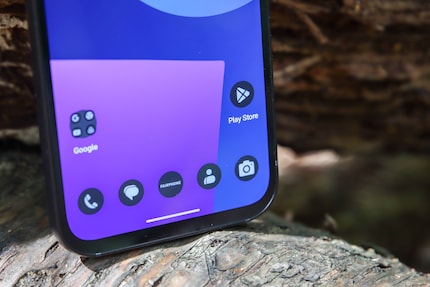
News + Trends
IFA 2023: Our reports from Berlin
by Luca Fontana

The Fairphone 5 is set to get eight years of software updates. As far as smartphones are concerned, that’s an eternity. When I put it to the test, the sustainable phone reveals numerous improvements compared to its predecessor.
The Digitec and Galaxus editorial team has been reporting live from IFA 2023 in Berlin. You’ll find all the news and background information we’ve published so far in our summary here:
Extended update periods aren’t the only way Fairphone is keeping its smartphone’s environmental impact lower than the competition’s. The phone’s manufactured using recycled materials and sustainably mined minerals. If it ever happens to break, its modular design ensures you’ll be able to fix it yourself. Though all this makes the Fairphone 5 relatively expensive, the price balances out if you use the phone for a long time.
The Fairphone 5 doesn’t have any of the typical Snapdragon or Dimensity chipsets installed in most smartphones. Instead, Fairphone has gone for Qualcomm’s QCM6490. When I saw the specs, I figured there must’ve been some mistake. But nope, this chipset really does exist.
The QCM6490, manufactured using the 6-nanometre process, offers not only 5G, but also Wi-Fi 6E and Bluetooth 5.2. It sports eight cryo processing cores, one of which clocks at up to 2.7 gigahertz. Three of them make it up to 2.4 gigahertz. Meanwhile, the remaining four are designed to use minimal power, clocking at up to 1.9 gigahertz. The Adreno 643 graphics chip clocks at 812 megahertz.

Qualcomm envisions the QCM6490 as a chipset for devices such as outdoor tablets, dashcams, point-of-sale systems and vending machines. Software-wise, it supports Android, Ubuntu, Linux and Windows 11 IoT Enterprise – and the manufacturer’s keen to talk up the long-term updates, too. This support is probably one of the main reasons Fairphone chose the chipset. During the product showcase, we heard the Fairphone 5 would be given eight years of software updates. In other words, they’ll be supported right up until 2031.
Fortunately, when you’re using the Fairphone 5, you don’t notice that it doesn’t contain a typical smartphone chipset. The reason? The QCM6490 is equipped for image processing and AI applications, among other things. It fares better in benchmark tests than the Fairphone 4’s Snapdragon 750G and outperforms the Xiaomi 13 Lite’s Snapdragon 7 Gen 1.
Overall, the QCM6490 proves to be a solid mid-range chipset. However, in conjunction with the phone’s 8-gigabyte RAM, it falls short of the latest top-level Snapdragon 8 Gen 2 chipset. This limitation aside, the Fairphone 5 is a very usable smartphone, decked out with hardware powerful enough for everyday use. That being said, the mediocre scores for computing interface OpenCL and graphics interface Vulkan suggest that graphically demanding games won’t be the Fairphone 5’s forte.
Fairphone’s fifth smartphone comes straight out of the box with Android 13. Head-to-head with Google’s standard version, you’ll only see a few differences on the user interface side. With Android 13, you also get access to the Fairphone app, which gives you additional information on the smartphone once you’ve logged in. The app also allows you to register your device for a 5-year warranty.
As for the aesthetics, I only noticed one change besides the background image – you can now set the app logos on your home screen to appear in black and white. The Nothing Phone (2) seems to have inspired other manufacturers in that respect.

As we’ve covered already, the Fairphone 5 is set to get software updates until 2031. The manufacturer hasn’t specified whether these eight years will only include security updates, or whether feature updates up to Android 21 will be included too. Mind you, Google has increasingly been adding new features to devices outside of major Android updates.
Fairphone’s goal is to sell sustainable smartphones. Durable hardware and years of software updates resulting in a long service life are just two crucial aspects of this. Fairphone sources 14 of the 50 materials used to manufacture the smartphone from fair and sustainable sources. While that sounds good, I can’t exactly verify if it’s really the case.
What I can put to the test, however, is whether the smartphone is easy to fix. The back cover comes off easily, and you don’t need any tools to replace the battery either. If the passing years take a toll on its power, replacing it is child’s play. A new battery will currently set you back about 40 euros or Swiss francs. Fairphone claims to offer long-lasting replacement parts, but hasn’t spelled out an exact period. There are tutorials on replacing the modules on the manufacturer’s YouTube channel.

However, not all of the Fairphone 5’s components can be replaced individually. There are 10 spare parts available, including the three cameras, USB-C port, speakers, display, back cover and top unit. The latter houses the time-of-flight sensor, camera flash and slots for the SIM and microSD cards. The central core housing the QCM6490, memory and other hardware isn’t available as a spare part.
Though taking the Fairphone 5 apart calls for a small Phillips screwdriver and a little dexterity, I don’t have to grapple with glued-down components you’d find in most smartphones. Provided the individual modules are available, repairing the Fairphone 5 at home is no problem.

I manage to get the back cover off without using any tools. The two large modules are held in place with five and seven screws respectively. In addition, the upper model has a connector cable. A small tool made of thin, sturdy plastic proves useful when prising the modules off the phone. The cameras are only attached via connectors and are held in place by the module on top of them. Another eight screws are used to attach the display to the frame.
Compared to its predecessor, the Fairphone 5’s screen has also been given an upgrade. Measuring in at 6.46 inches, the OLED display boasts a resolution of 2,720 × 1,224 pixels. Pitted against the Fairphone 4’s LCD screen, the Fairphone 5’s is noticeably brighter and has darker blacks and more vivid colours. The refresh rate reaches up to 90 Hz. Though decent, this comes in below the 120 hertz that’s become commonplace – even in the mid range.

If you ask me, the display leaves nothing to be desired during everyday use. That’s just as true in sunlight – when the screen needs to shine brightly – as it is when night starts to fall.
You can add to the 256-gigabyte internal storage by using a microSD card. Not only that, but the Fairphone 5 also has room for a nano SIM. You do, however, have the option of using an eSIM too.
Fairphone has increased the battery’s capacity to 4,200 mAh for the 5. In the Fairphone 4, it was 3,905 mAh. Even so, don’t expect to see any major differences in battery life. Mine lasts me through the day, but two days proves to be too much. I’d need to use the phone very sparingly to manage that.

When it’s charging, the Fairphone can take up to 30 watts – that’s 50 per cent more than its predecessor. The phone doesn’t come with a charger. As long as you’ve got the right power supply, 20 minutes of charging should fill the battery halfway. When I tried it out with my chargers – some of which go significantly higher than 30 watts – it wasn’t quite as fast as this. But I’m not going to get pedantic over a few measly minutes. Mind you, giving the phone a full charge took another hour.
The Fairphone 5 has two cameras on the back as well as a front camera for selfies. All three have a resolution of 50 megapixels, but use different sensors. Meanwhile, the lenses have different focal lengths.
Pixel binning to 12 megapixels is enabled by default in all three. While you can choose the full 50-megapixel resolution for the main- and ultra-wide-angle cameras, it’s limited to 12-megapixels for the front camera.

Some backlight at the top slightly dampens my impression of the camera. Compared with the Fairphone 4, however, the colours produced by the Fairphone 5’s main camera look more vivid – without looking unnatural.


Looking at the full size images, however, there’s no discernable difference in the level of detail. Mind you, the previous Fairphone was already good enough in this respect.
Still, the Fairphone 5 clearly comes up trumps when it comes to handling unfavourable lighting conditions with strong contrasts. In this example, the image doesn’t look as overexposed in light areas.


In a decent level of daylight, however, these quality differences are of little consequence. The only noticeable thing is that the Fairphone 5’s main- and ultra-wide-angle cameras have smaller focal lengths than their Fairphone 4 counterparts.


I’m far less tempted to use the digital zoom. Sure, the Fairphone 5’s offers up to 20x magnification. But even at 8x zoom (its predecessor’s maximum) the picture quality has little appeal – and isn’t much better than the Fairphone 4.


Once darkness falls, however, the Fairphone 5’s enhancements start to become apparent. Even using Automatic mode, the level of detail gets a boost. What’s more, I prefer the lighting. The effect is even stronger when you turn on Night mode.




Even in Automatic mode, the improvements made to the ultra-wide-angle camera come to the fore in darkness. There’s no comparison available for the Night mode, as the Fairphone 4 only offered the option on its main camera.



When you’re taking a selfie, you notice the wider angle on the Fairphone 5’s front-facing camera. Colour-wise, the differences are marginal. However, the closer I get to the original size, the more I notice the new smartphone’s higher level of detail.


In the dark, I’d recommend using Night mode. Another new feature for the Fairphone 5’s selfie camera, it not only delivers better-illuminated images, but also a higher level of detail.

The speaker does alright during phone calls. However, if you switch to speakerphone or put music on, the sound is sub par – even for a smartphone. The speaker rattles and the sound is tinny. Even if I were fresh from a Rolling Stones gig, I still wouldn’t «get no satisfaction» from that sound. Incidentally, this doesn’t just apply to the phone I’m testing. We’ve noticed poor sound quality on several devices here at Galaxus. The only thing that helps is to use headphones or Bluetooth speakers.

The Fairphone 5 is a big improvement on the Fairphone 4. This time around, you won’t need to sacrifice as much to have a clear conscience. Compared to its competitors, it’s relatively pricey for a mid-range smartphone. It does, however, score a few brownie points as a result of its long service life, easy repairability and better sustainability.
Its unusual chipset equips the Fairphone 5 with enough power. The display’s beautiful, while the camera is good on average. You get a decent amount of battery life, and the battery itself can be replaced. My only bugbear is the pitiful speakers.
If sustainability isn’t enough to wow you, there’s a tempting selection of smartphones at the same price as the Fairphone 5, including the Nothing Phone (2) and the Pixel 7. Even this year’s flagship models (without the «Ultra» or «Pro» suffix) such as the Galaxy S23 and the Xiaomi 13 only cost slightly more.
Switzerland
Germany
Header image: Jan Johannsen
As a primary school pupil, I used to sit in a friend's living room with many of my classmates to play the Super NES. Now I get my hands on the latest technology and test it for you. In recent years at Curved, Computer Bild and Netzwelt, now at Digitec and Galaxus.